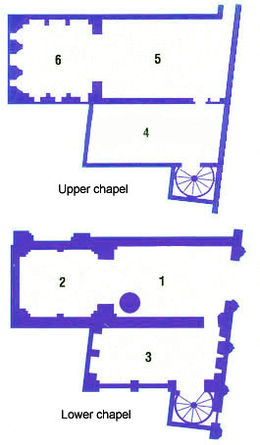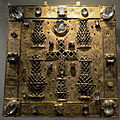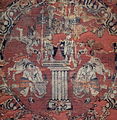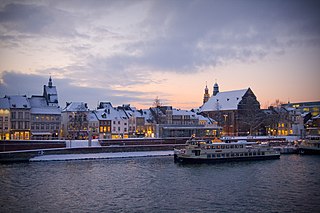
Maastricht is a city and a municipality in the southeastern Netherlands. It is the capital and largest city of the province of Limburg. Maastricht is located on both sides of the Meuse, at the point where the Jeker joins it. Mount Saint Peter (Sint-Pietersberg) is largely situated within the city's municipal borders. Maastricht is adjacent to the border with Belgium and is part of the Meuse-Rhine Euroregion, an international metropolis with a population of about 3.9 million, which includes the nearby German and Belgian cities of Aachen, Liège, and Hasselt.
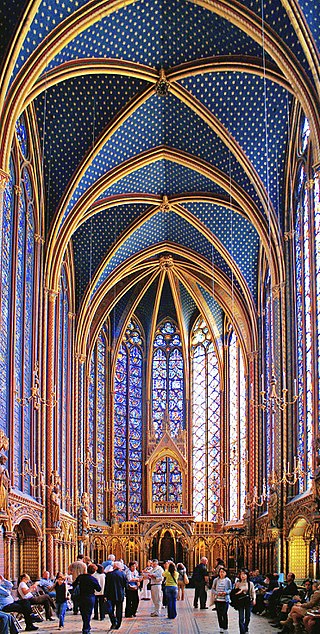
The Sainte-Chapelle is a royal chapel in the Gothic style, within the medieval Palais de la Cité, the residence of the Kings of France until the 14th century, on the Île de la Cité in the River Seine in Paris, France.
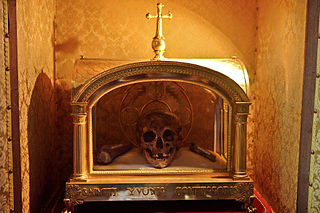
In religion, a relic is an object or article of religious significance from the past. It usually consists of the physical remains or personal effects of a saint or other person preserved for the purpose of veneration as a tangible memorial. Relics are an important aspect of some forms of Buddhism, Christianity, Islam, shamanism, and many other religions. Relic derives from the Latin reliquiae, meaning "remains", and a form of the Latin verb relinquere, to "leave behind, or abandon". A reliquary is a shrine that houses one or more religious relics.

A reliquary is a container for relics. A portable reliquary may be called a fereter, and a chapel in which it is housed a feretory or feretery.

Schatzkammer, a German word which means "treasury" or "treasure chamber", is a term sometimes used in English for the collection of treasures, especially objets d’art in precious metals and jewels, of a ruler or other collector which are kept in a secure room and often found in the basement of a palace or castle. It also often included the wider types of object typical of the Renaissance cabinet of curiosities. A very small but evocative Renaissance room in a tower at Lacock Abbey was designed for keeping and viewing the treasures of the newly rich owner.
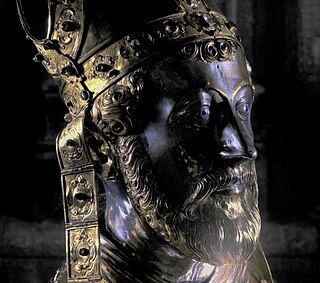
Saint Servatius was bishop of Tongeren —Latin: Atuatuca Tungrorum, the capital of the Tungri—. Servatius is patron saint of the city of Maastricht and the towns of Schijndel and Grimbergen. He is one of the Ice Saints. His feast day is May 13.
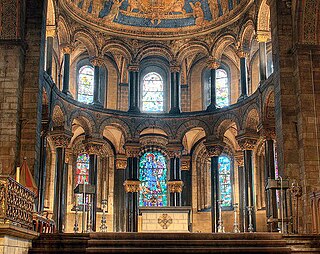
Mosan art is a regional style of art from the valley of the Meuse in present-day Belgium, the Netherlands, and Germany. Although in a broader sense the term applies to art from this region from all periods, it generally refers to Romanesque art, with Mosan Romanesque architecture, stone carving, metalwork, enamelling and manuscript illumination reaching a high level of development during the 11th, 12th and 13th centuries.

Gerlach was a 12th-century Dutch hermit. His cult is centered at Houthem near Valkenburg in the south of the province of Limburg.

The Basilica of Saint Servatius is a Roman Catholic church dedicated to Saint Servatius, in the city of Maastricht, the Netherlands. The architecturally hybrid but mainly Romanesque church is situated next to the Gothic church of Saint John, backing onto the town's main square, Vrijthof.
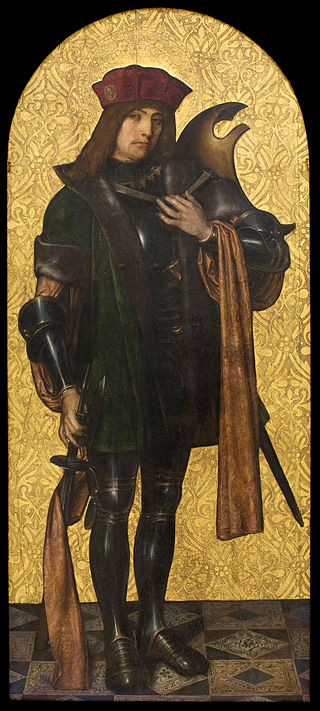
Candidus was a commander of the Theban Legion. The Theban Legion was composed of Christians from Upper Egypt. He is venerated as a Christian saint and martyr.

Christianity has a strong tradition of pilgrimages, both to sites relevant to the New Testament narrative and to sites associated with later saints or miracles.
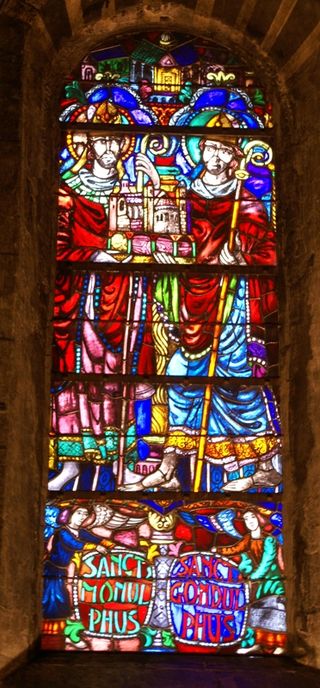
Monulph was a sixth-century bishop of Tongeren and Maastricht, and is revered as a Roman Catholic saint.
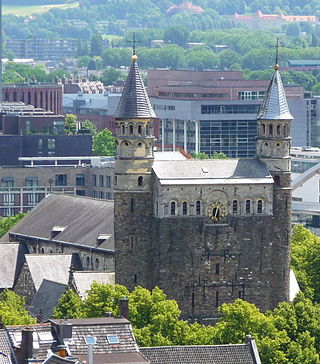
The Basilica of Our Lady is a Romanesque church in the historic center of Maastricht, Netherlands. The church is dedicated to Our Lady of the Assumption and is a Roman Catholic parish church in the Diocese of Roermond. The church is often referred to as the Star of the Sea, after the church's main devotion, Our Lady, Star of the Sea.

Maastricht silver is a collective name for silver objects produced in Maastricht, Netherlands, mainly in the 17th and 18th centuries, when the town was a major centre for silversmithing.

The Treasury of St. Vitus Cathedral is a collection of ecclesiastical treasures of the Prague Cathedral and is in the property of Prague Cathedral Chapter. It is the largest church treasury in the Czech Republic and one of the most extensive in Europe. The Treasure contains more than 400 items, 139 from them have been displayed since 2012 in a new exhibition in the Chapel of the Holy Rood in Prague Castle.

A church treasury or church treasure is the collection of historical art treasures belonging to a church, usually a cathedral or monastery. Such "treasure" is usually held and displayed in the church's treasury or in a diocesan museum. Historically the highlight of church treasures was often a collection of reliquaries.
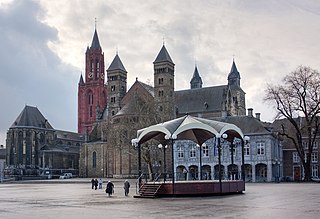
Vrijthof is a large urban square in the centre of Maastricht, Netherlands. The square developed from an ancient Roman and Frankish cemetery into a semi-private space that belonged to the Collegiate Church of Saint Servatius. In the 19th century, it became the town's main square. It is surrounded by important heritage buildings, museums, a theatre, and a range of hotels, restaurants, and bars. The square is regularly used for public events.

The Trier Cathedral Treasury is a museum of Christian art and medieval art in Trier, Germany. The museum is owned by the Roman Catholic Diocese of Trier and is located inside the Cathedral of Trier. It contains some of the church's most valuable relics, reliquaries, liturgical vessels, ivories, manuscripts and other artistic objects. The history of the Trier church treasure goes back at least 800 years. In spite of heavy losses during the period of the Coalition Wars, it is one of the richest cathedral treasuries in Germany. With the cathedral it forms part of a UNESCO World Heritage Site.

The Pilgrimage of the Relics or Maastricht Septennial Pilgrimage is a seven-yearly Catholic event in the Dutch city of Maastricht. Originating in the Middle Ages, it developed from a pilgrimage to the grave of Saint Servatius into the present-day religious, historical, cultural and commercial enterprise. Highlights in the programme are the displaying or unveiling of the relics in the main churches and secondly, the processions with the town's main relics. The next pilgrimage will take place in 2025.

The Treasury of St Mark's Basilica contains the church treasure or collection of sacred objects and reliquaries kept in St Mark's Basilica in Venice, Italy. The treasure constitutes the single best collection of Byzantine metalwork and enamels that survives, many of the items having been looted during the Fourth Crusade of 1204. The treasury also contains some significant artworks made for the basilica itself, but no longer used there.




